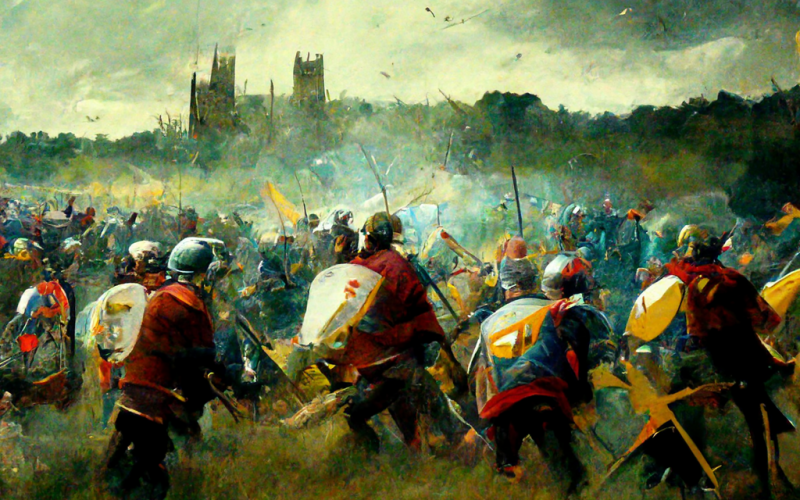Thou shalt not make a machine in the likeness of a human mind.
The Orange Catholic Bible (Frank Herbert, DUNE)
I’ve come up with a set of rules that describe our reactions to technologies: (1) Anything that is in the world when you’re born is normal and ordinary and is just a natural part of the way the world works. (2) Anything that’s invented between when you’re fifteen and thirty-five is is new and exciting and revolutionary and you can probably get a career in it. (3) Anything invented after you’re thirty-five is against the natural order of things.
Douglas Adams, The Salmon of Doubt
Ever since Čapek’s 1920 play R.U.R., pop culture has had machine uprisings on the mind. We’ve been expecting it for about a century now, and it seems to follow the trend of the concerns of the day: it was a worker uprising in R.U.R., and nuclear annihilation in The Terminator. In The Matrix, humanity is not exterminated, but instead pacified by a virtual world designed not to entertain us, but entrap us.
We’re still worried about a robot uprising, of course. In this modern era of drone strikes and facial recognition, Boston Dynamics engineers gleefully post videos of their dancing robots without realizing that everyone else is expecting with horror that their “helpful” creations will inevitably chase us through the streets with machine guns in a few years, either in the service of some rogue central computer, or (more likely) a human dictator. Extermination by a literal robot may not be our immediate concern in this atomic age, but we can likely expect to be “pacified” by one during the civil unrest arising from the next pandemic or the Water Wars. The robot uprising seems more plausible than ever (although they’re more likely to be used as just another tool of the state to oppress the masses).
All this is to say that “robot replacement” isn’t exactly a new concern, whether our job is to pull levers in some factory, or work as a visual artist. If you’ve been on the internet at all this year, at least in nerd spaces like the RPG community, you’ve no doubt seen plenty of “AI Generated” art popping up everywhere and clogging up your feeds. And I’m sure you’ve seen plenty of hand-wringing about it too– “will AI replace artists/authors/editors/etc.?” I don’t really know one way or the other, but mostly I expect we’ll all be subjected to a trend of AI-Illustrated content for a year or two, similar to how it was hip for a while to film things with super-narrow depth of field once full-frame video SLRs became widely available.
I’ve been mostly ambivalent about this whole AI art thing, but after a while I started to notice a pattern: it’s pretty good at surreal weirdscapes. It might be a while before the algorithms can actually produce viable art along the lines of “Norman soldiers clash with Anglo-Saxons at the Battle of Hastings,” but making strange, unsettling images with these programs is definitely Easy Mode. They are, in other words, rather like a sophisticated sort of Random Table that can produce odd and interesting results as a creative prompt.
But, when I think “surreal weirdscapes,” I think: “Carcosa!” Out of curiosity, I made a few images in Midjourney to see what it might cook up to illustrate Geoffrey McKinney’s science-fantasy setting. Some folks can really play that generator like a fiddle, but my prompts were just basic plaintext stuff, like “blue man with cyborg eyes carrying a dagger” to see what it could crank out with a somewhat minimal effort.






All in all, it made some interesting images with its “default” settings, although I have to admit it’s not really what I envision in my head if I were describing such scenes to players. It’s just a little too moody for me, and seems to lean toward a “Stephen Grammel makes 1970s sci-fi fantasy book covers” look, which isn’t a bad thing, but it’s not quite what I’m looking for. The robots seem to have a very bio-mechanical dendrite look, and Midjourney seems to struggle with “drawing” a dinosaur. It might not be super useful if I were attempting to make some quick illustrations for a grounded adventure concept (e.g., “Here’s what the Citadel of the Radiant Sons looks like,” or “you see the spear-waving warriors clinging to a howdah on a T-Rex”), but it might be helpful for a quick “filler” illustration for web posts like this.
Will AI art replace real artists? I’m not sure. On the one hand, probably not, but on the other hand, it might really impact the commissions market (whatever it may be). Such imagery may prove to be a real boon to DIY folks who rely on public-domain works to illustrate zines, self-printed pamphlet adventures, or blog posts, and that’s what I’d probably use if for too. But, if I were making a proper product, I’d still commission some human-made art–it’s got more heart, after all, and if/when AI generators can master something like “Elven ranger dwarf fighter human wizard fight owlbear in the woods” it would probably just end up looking like 5th edition art anyway.
